You are researching BIOTIX, volatile microorganisms that react when you get too many in the same petri dish, along with a team of lab personnel. Well, I use the term “team” loosely, because really you’re all a bunch of ruthless backstabbers, competing to get your names attached to Dr. Johannae’s ground-breaking research paper.
At a glance: BIOTIX is a game by Zach Huff for 2 to 5 players, ages 14 and up, and takes 30–40 minutes to play. It’s available now in game stores and online, and retails for $19.99. Although the box says it’s for teens and up, I played with my 10-year-old without any trouble, and I think probably 8-year-olds with some gaming experience wouldn’t find it too difficult to pick up the rules, either.
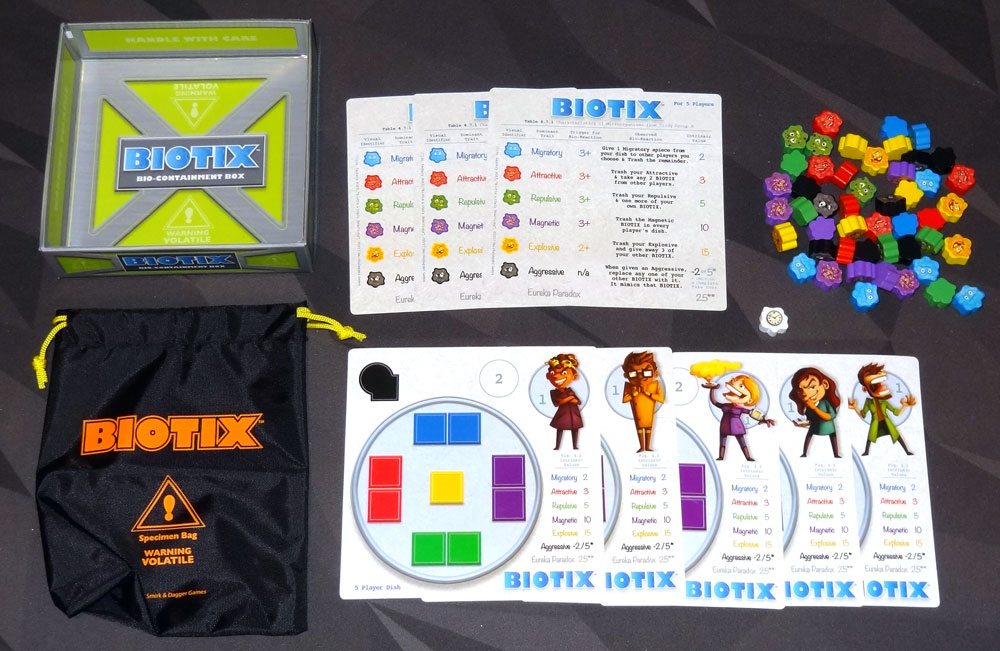
Components
- 1 Specimen bag
- 48 BIOTIX meeples (8 each in 6 colors)
- 1 Timer meeple (white)
- 5 Petri Dish cards
- 3 Player Aid cards
Before you first play the game, you’ll have to sticker the meeples (assuming you want stickers on them). The stickers give the biotix funny faces and it definitely makes the game more interesting visually, but it takes a while and we found that some of the shapes aren’t a perfect match for the silhouette of the stickers.

The specimen bag is a nylon pouch—it holds all the meeples with plenty of room to mix them up, and it’s large enough that it’s fairly easy to put your whole hand in to draw out meeples.
The petri dishes are just large square cards, as are the player aid cards; they’re double-sided, with one side for 2–4 players and the other side for 5 players. The petri dish cards also have some crazy-looking scientists on them, just to give them a little personality.

The box also serves as the “bio-containment box” for biotix that are trashed during gameplay, but it’s not entirely clear to me how it’s supposed to work. There’s a cardboard insert that was on top, covering all the components, when I first opened the game, but it’s not really practical to use during the game in this configuration.
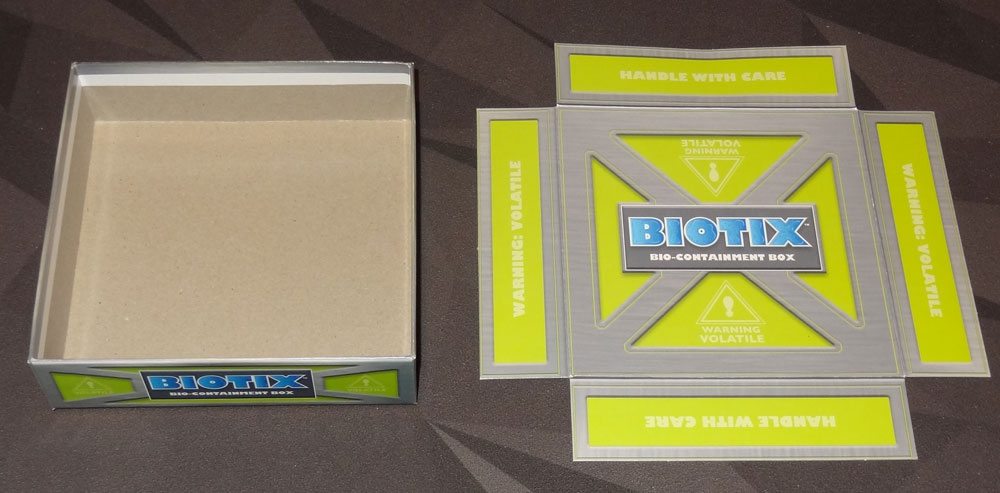
The text on the sides of the insert makes it look like it should fit into the box bottom, printed side showing, but the instructions say to put trashed BIOTIX hidden into the bio-containment box. As you will see from the gameplay photos, we just tossed them into the open box, so they were still visible. [UPDATE: Curt Covert of Smirk & Dagger commented that it is in fact supposed to be the box liner, and was packed incorrectly. He recommends keeping the box lid mostly covering the box to hide the trashed meeples.]
How to Play
The goal is to score the most points by collecting BIOTIX in your petri dish—and by sabotaging your opponents.
Each player gets a petri dish, flipped to the appropriate side based on number of players. Put the BIOTIX into the bag except for the black ones, which are used with advanced rules. (In a 2-player game, remove one of each color.) Give the timer meeple to the start player, placing it on the “3” on the countdown track above their petri dish. (In a 5-player game, it goes on the “2” spot.)
The game is played over the course of three research “days,” and each day can take multiple rounds.

On your turn, first you draw two BIOTIX from the bag. Then, place them one at a time: each one can be placed on your own petri dish, or given to an opponent to place on their petri dish. Each time a BIOTIX is placed, you check for a bio-reaction. If there are more of a color than will fit in the corresponding spaces on the petri dish, they react according to the player aid cards:
- Blue Migratory: Give 1 blue meeple to each opponent, and then trash the rest.
- Red Attractive: Trash your red meeples, then take any 2 meeples from other players.
- Green Repulsive: Trash your green meeples and one more of your own.
- Purple Magnetic: Trash all purple meeples.
- Yellow Explosive: Trash your yellow meeples, then give away 3 of your remaining meeples to other players.
Trashed meeples go in the bio-containment box and will only be mixed back in at the end of the research day.
The start player will move the timer token one space each time the bag is passed to them. If it would be moved off the “1” spot, then the timer token goes into the bag.

The research day ends immediately as soon as the timer token is pulled from the bag (so the player that draws it does not place the other meeple drawn that turn). At the end of the day, players add up the values of the BIOTIX left in their petri dishes. Then, each player trashes two BIOTIX from their petri dish and leaves the rest. Mix all of the trashed BIOTIX back into the bag, give the timer token to the player who drew it, and start a new day.
After three days, the player with the highest score wins.
There’s a catch-up mechanic called the Eureka Paradox: after the second research day, if you’re 20+ points behind the leader, you can do side research. Write down a color and a number from 1–3 on a scrap of paper and hide it under your petri dish. At the end of the third day, if you have that exact number of that color, you score a 30-point bonus.
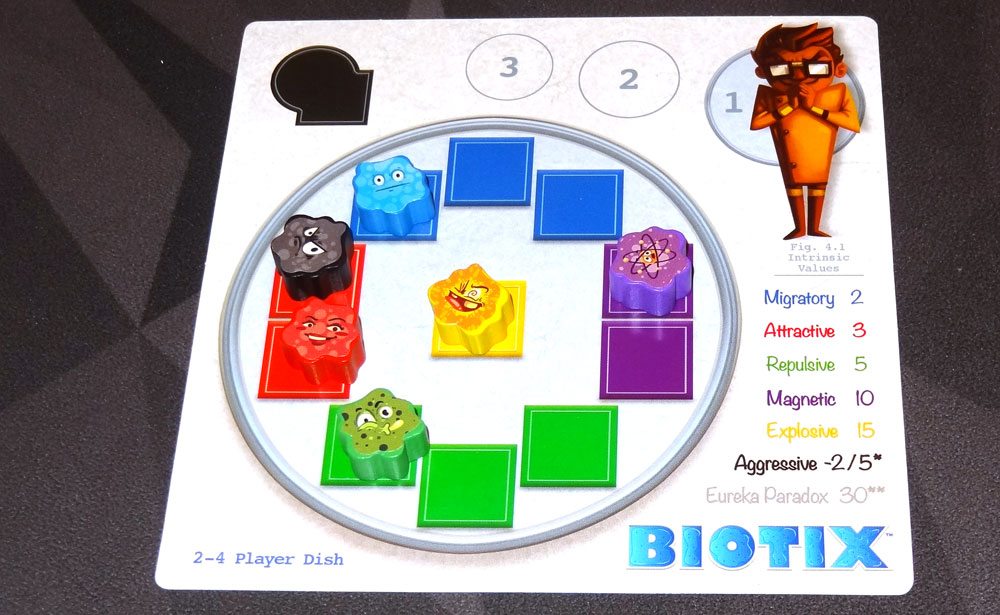
The black BIOTIX are used for the advanced rules. Black BIOTIX are aggressive, and will be mixed into the bag at the beginning of the game. When you place a black BIOTIX, you must replace one of your existing non-aggressive BIOTIX, if any. If you don’t have any non-aggressive BIOTIX, then it can be placed anywhere. Aggressive BIOTIX react as if they’re the color they’re mimicking. However, they are worth -2 points instead of the usual value. The exception is if you have only black BIOTIX at the end of the day, in which case they’re worth 5 points each.
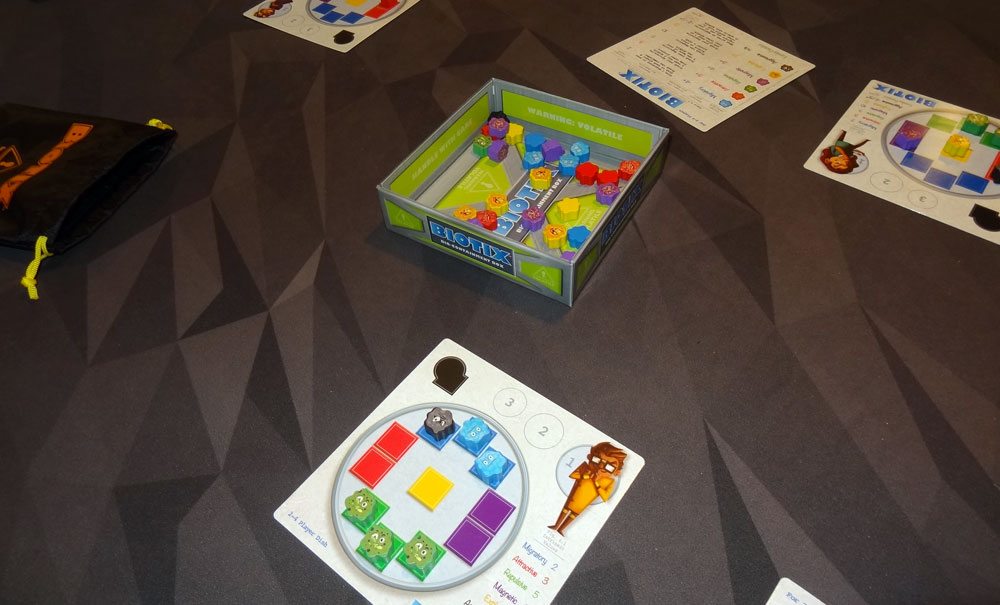
The Verdict
BIOTIX is from Smirk & Dagger Games, so I expected it to have some degree of spite and “take that”—and I wasn’t disappointed. In this game, you get a lot of opportunities to sabotage your opponents, but don’t be surprised when they sabotage you.
The key is that the more valuable the variety of BIOTIX, the more harmful it is when it reacts. The yellow Explosive BIOTIX is worth 15 points all by itself (compared to a measly 2 points for the blue Migratory), but you can only hold one at a time. Get another, and not only do you lose the yellow, but you also have to give away three others to other players. Of course, not even that is terrible, because those others might trigger chain reactions for other players as well.
When it’s your turn, you always have to do a little bit of risk assessment: do you keep the BIOTIX you drew for yourself, hoping that the research day will end before you get too many of them? Or do you give them to other players, hoping they’ll react soon? It can get tricky, because every BIOTIX you give away gives points to your opponent unless you can get rid of it before scoring.
The end of the day can be somewhat unpredictable, too. Everyone is guaranteed at least a few turns, while the timer token moves down the countdown track. But once it goes into the bag, you never know how soon the day will end. I’ve had some instances in which the timer was pulled on the same turn it was put into the bag, and others where it was the last meeple left in the bag, which meant that there were a lot of reactions during that day.
Once everyone is familiar with the game, the Aggressive BIOTIX variant gets pretty interesting. Because they replace other meeples first, each one that you place on your petri dish reduces your score significantly without bringing you closer to a reaction that might get rid of them, so at first it seems like a good idea to give them all to opponents. However, the option to “shoot the moon” by collecting only black meeples makes it important to balance it out a little.
Overall, BIOTIX is fairly easy to learn and plays pretty quickly, and the relatively small box makes it easy to take with you for a fast game session. I do want to reiterate, though, that it’s not necessarily a game for people who want to play nice, or who will feel bad when they wreck an opponent’s plans. But if you love messing with other players, it’s a lot of fun.
Disclosure: I received a review copy of this game.
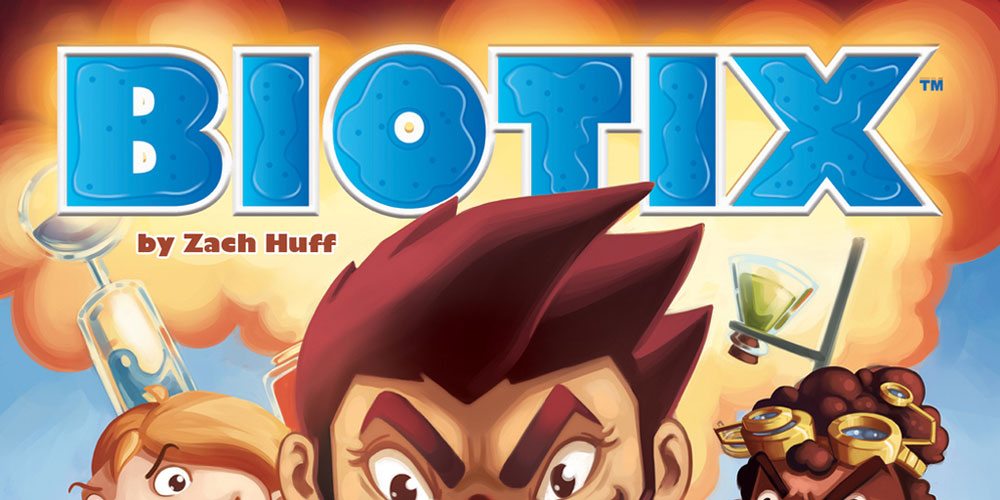
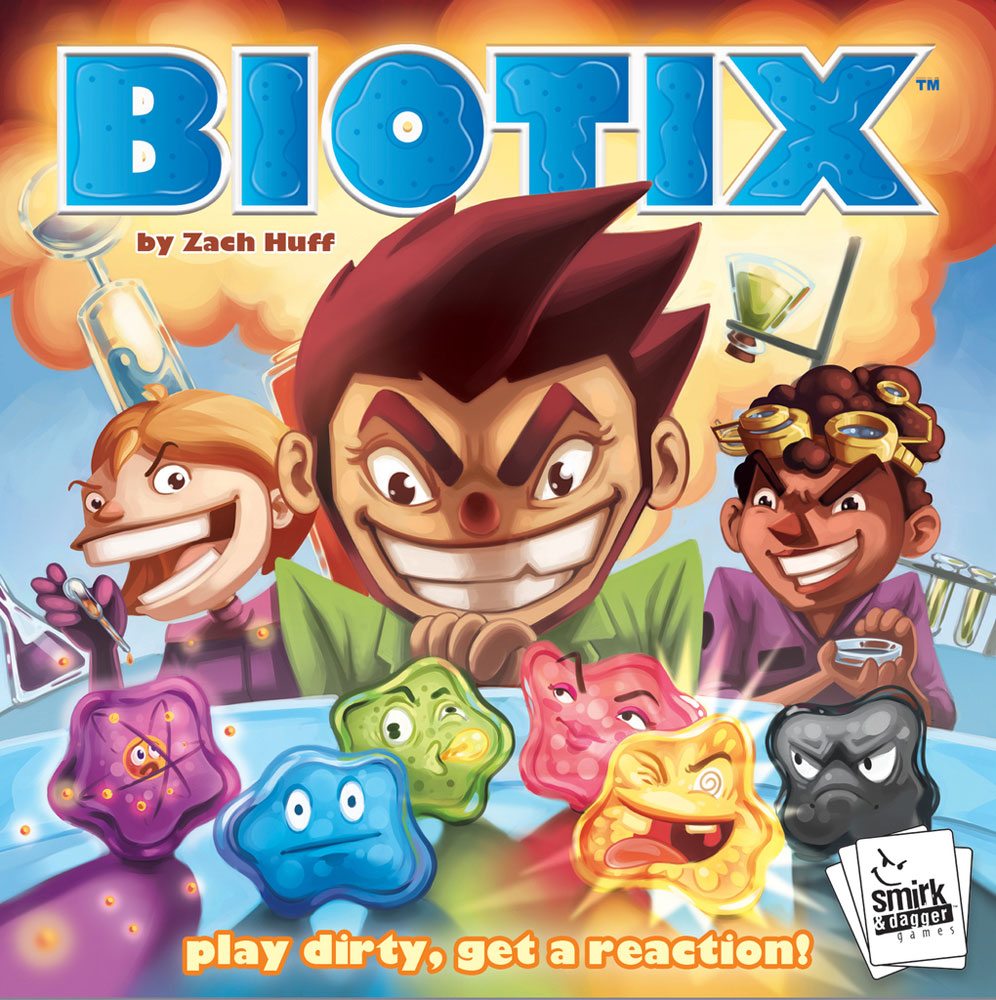



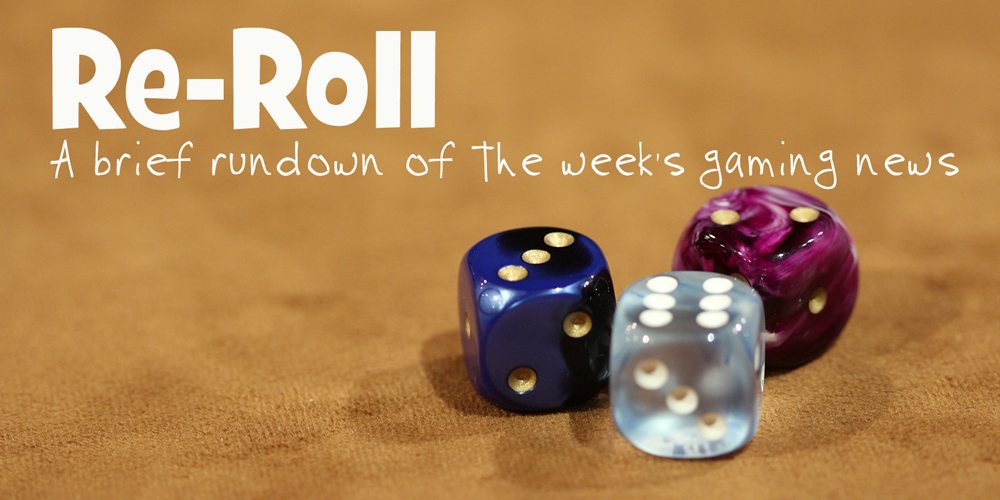
Great overview and review, Jonathan. BTW the ‘Bio-containment’ insert was placed into the box incorrectly. It was intended as a liner for the bottom of the box. So players can just refold it the opposite direction – and then their box bottom will be as beautiful as intended.
Good to know! But then my other question is: how do you hide the trashed BIOTIX? Do you put the box lid over it?
My question is when ypu replace with black do they go to trash or back in the bag because saying replace and not trash makes me wonder it does’t say anything about it in the rules.
By they i mean the color you replaced
Hi—the one that is replaced goes in the trash, not back in the bag.